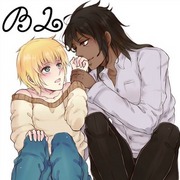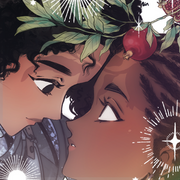My way of writing is, actually, pretty stupid. I have a sentence or scene pop into my mind, and I ruminate over it. Sometimes it goes nowhere and gets discarded, sometimes I have what I think will be a good beginning, but no real ending and it gets discarded. Sometimes I have a whole story but it’s not very long, so I scribble it down and then it usually gets discarded. As you can, lots of stuff gets discarded. But sometimes I hit on something that forms in my mind like a weird little Athena and by the time I know what’s happened she’s dressed for war and ready to go.
The Tottori trilogy was like that. It was inspired by several manga, Liberty and Octave to be specific, but I didn’t care how either of those went with things, so I began to mold and shape it in my rough outlines. I consider my characters to be the heart of every story. No matter what is happening with them or to them or around them, they are always my primary focus. Physical characteristics, mannerisms, personality, things like that. Then it switches to the social status.
Status, whether we like to admit it or not, is vital to understanding a character. Someone who grew up in the lap of luxury will react differently to situations as someone in the middle class or someone dealing with poverty. While the scientific nature vs. nurture debate rages on, it makes sense to me, so I come down on the side of nurture. Not only social strata, of course, but also location in important.
In Kunoichi it made sense that, though their backgrounds were different, the location would have to be somewhere like Tokyo. After all, you can’t have big music stars wandering the wilds singing and dancing to passing tanuki. While tanuki are adorable, as a general rule of thumb, they just don’t care about choreography.
While I loved writing Kunoichi I wanted something very different with this series. Kasumi was just a girl from a middle-class family living in the least populated prefecture in all of Japan. She had a simple life with a mother and, to a lesser extent, father who were very traditionally Japanese.
I should note that when I say “traditionally Japanese” I do not mean backwards in any way shape or form. Traditions are important for a cultural identity and in a society like America it is one of the factors which differentiates us from everyone else. In Japan it is one of the factors which binds people together. For Japanese tradition means different things to different families. In the case of Kasumi’s family marriage or relationships is strictly between a man and woman. Or, in Jun’s case, between a man and however many women he can con into bed. Even then, though, his…er…indiscretions…are ignored, when possible, brushed under the rug when convenient or explained away when necessary. Though Kasumi’s mother is plainly the disciplinarian of the house, she takes a subservient role to her husband when push comes to shove as that is part of their tradition and they expect their children to continue those traditions.
Aria, meanwhile, is from a very wealthy family hailing from California. She has never wanted for anything and, with her looks and status, whether it’s an object or person, she’s generally been able to get it. Her family simply wants her to not be an embarrassment to them. To be seen and not heard, as it were. They’re fine with whatever she does provided she doesn’t cause a scene. Unfortunately, she caused just such a scene at her previous school which is what led to her going to visit her uncle in Japan.
So, with those two characters and their dynamics in place I began to write. Originally the book was going to be a single novel but as it got longer and longer and I felt rushing an end would be unfair to my characters and anyone who happened to want to read it, I began to consider whether or not I had enough material for a second book. I soon realized I had enough for not only a second but also a third book if I wanted to tell the story properly.
Each novel is set up as less a traditional three act novel but more as a series of incidents. The inciting incident in act one would, obviously be very early when Aria shows up to class. But there are no M. Night Shyamalan “what a twist” moments. It’s just a girl trying to figure out what her feelings for another girl mean. So, in a very real way, it’s not a traditional novel.
The second book is similar to the second act in a three-act structure wherein obstacles are introduced to test the resolve of the characters. The third novel will be the climax of the series. I intend each book to be able to read individually without the other two so there will be resolution of some threads in the second novel. I dislike novels ending on cliffhangers since they take so long to write I usually forget what the cliffhanger was whenever I read one and then am excited to read the next but I’m never really sure why I’m excited. I don’t wish to leave anyone hanging so I promise I will wrap up whatever I can by the end of each book.
As for what the third and final book entails, I can’t say much, only that it will not take place, by and large, in Tottori and there will be a time skip of more than a month. With that novel I plan to tie up all the loose threads through the books and present an ending which I hope you will enjoy and find fulfilling, at least a little.
For next week’s notes and things that mostly just interest me I’ll explore Tottori a little and give you an overview of the region, history, and people living there. In the meantime, I hope you are safe and happy and this season. Whether it’s Christmas, Hanukkah, Kwanzaa, or in my case sitting around watching anime and getting my krunk on with non-alcoholic egg nog, I hope it brings you nothing but joy and peace.
Yours,
Menchi Katsu













Comments (0)
See all